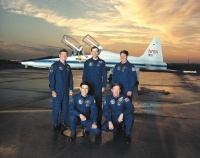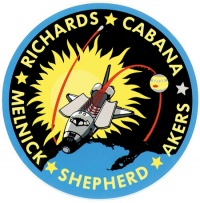STS-41
From The Space Library
 | |
| Organization | NASA-OfficeofSpaceFlight(UnitedStates) |
|---|---|
| Mission type | Earth Science,Human Crew,Solar Physics |
| Launch date | October 6, 1990 |
| Launch vehicle | Space Shuttle |
| Carrier rocket | {$Carrier Rocket} |
| Launch site | Cape Canaveral, United States |
| COSPAR ID | 1990-090A |
| Mass | {$Mass} |
| Experiments | Here |
| Alternate Names | SSBUV02,20841 |
| Nominal Power | {$Nominal Power} |
| Additional Information | Here |
| Data Collection | Here |
| Payload Mass Up | 22140.0 kg |
STS-41 was the 11th Discovery flight with Richard Richards, Robert Cabana, Bruce Melnick, William Shepherd, and Thomas Akers on board. This mission deployed the Ulysses spacecraft, a joint, NASA/ESA mission to study the poles of the sun and the interplanetary space above and below the poles. Two upper stages, Inertial Upper Stage (IUS) and a mission-specific Payload Assist Module-S (PAM-S), combined together for first time to send Ulysses toward out-of- ecliptic trajectory. Other payloads and experiments: Shuttle Solar Backscatter Ultraviolet (SSBUV) experiment; INTELSAT Solar Array Coupon (ISAC); Chromosome and Plant Cell Division Experiment (CHROMEX); Voice Command System (VCS); Solid Surface Combustion Experiment (SSCE), Investigations into Polymer Membrane Processing (IPMP); Physiological Systems Experiment (PSE); Radiation Monitoring Experiment III (RME III); Shuttle Student involvement Program (SSIP) and Air Force Maui Optical Site (AMOS) experiment. The mission duration was 96 hours 10 minutes 2 seconds.

